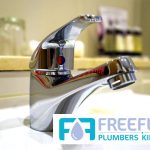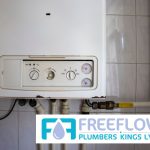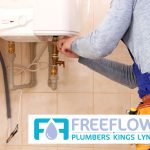Feeling alarmed when confronted with a plumbing emergency in the UK? Don’t fret! This guide will provide you with the necessary details to promptly shut off your water supply and prevent further harm.
We will walk you through the process, starting from locating the main shut-off valve to closing off individual fixtures. By following these straightforward instructions, you will regain command over any plumbing emergency and take the required measures to avert potential catastrophe.
Find the Main Water Shut-Off Valve
To access the main water shut-off valve in an emergency plumbing situation in the UK, you’ll need to locate it near where the water supply enters your home, such as in a basement or utility room. It is essential to be aware of this location prior to any emergency so that you can quickly access it.
To identify the main shut-off valve, look for a round or lever handle that controls the flow of water into your home. Once you have located the valve, inspect for any water leaks close to it. Leaks could indicate a difficulty with the valve or nearby pipes and should be taken care of immediately.
Now that you know how to locate and check for leaks near the main shut-off valve, let’s progress to turning off the water supply to individual fixtures without causing further damage.
Turn off the water supply to individual fixtures
You can shut off the water supply to specific fixtures by using the individual shut-off valves. These valves are usually located under the sink or behind the toilet.
To isolate the water for tap repair, locate the shut-off valve near the fixture that needs attention and turn it clockwise until it is fully closed. This will stop the flow of water to that particular fixture while allowing other fixtures in your home to still have water.
It is important to know where these valves are located so you can quickly and easily shut off the water if there is an emergency or a need for repairs.
Moving on to another method of shutting off the water supply – using the stopcock.
Use the stopcock to shut off the water supply.
If the water supply needs to be shut off, one option is using the stopcock. The stopcock is a valve that controls the flow of water into your property and is usually located under the kitchen sink or in a utility room.
To shut off the water quickly and effectively, turn the handle clockwise until it is fully closed. Ensure that any appliances that use water are turned off before shutting off the stopcock.
If you are unsure about how to operate the stopcock, consult an experienced plumber for assistance.
Consider installing emergency shut-off valves to have extra convenience and peace of mind in case of future water supply system emergencies.
Consider installing emergency shut-off valves.
Consider installing emergency shut-off valves for added convenience and peace of mind in the event of future water supply emergencies. These valves are designed to quickly and easily stop the flow of water to specific areas or fixtures in your home, allowing you to isolate any potential leaks or problems.
By having emergency shut-off valves installed, you can minimise damage caused by burst pipes or other plumbing emergencies. Regular plumbing maintenance is crucial to ensure that these valves are functioning properly and can be relied upon when needed.
It is important to have a professional plumber inspect and maintain your shut-off valves on a regular basis, as they can identify any issues and make necessary repairs or replacements. Knowing when to call a professional plumber is essential in maintaining the effectiveness of your emergency shut-off valves and ensuring the safety of your home’s water supply.
Transition: What are some signs that indicate it’s time to call a professional plumber?
Know When to Call a Professional Plumber
When it comes to recognising when to call a professional plumber, it is crucial to be aware of unique smells or sounds coming from your plumbing system. These could be signs of a potential plumbing crisis that requires immediate action.
Other indications include persistent leaks, low water pressure, and discoloured water. Ignoring these warning signs can lead to more severe damage and costly repairs in the future.
To prevent plumbing issues, regular maintenance is essential. Plan regular inspections and promptly address any minor issues before they escalate into major problems.
In addition, practicing good habits such as avoiding flushing non-biodegradable items down the toilet or pouring grease down the sink can help maintain the integrity of your plumbing system.
Remember, early detection and proactive measures are crucial in avoiding emergencies and ensuring the longevity of your plumbing infrastructure.
Frequently Asked Questions
How do I locate the main water shut-off valve in my home?
To locate the main water shut-off valve in your home, begin by searching for a metal or plastic box labelled ‘Water Shut-Off.’ It is typically positioned near the boundary of your property.
If you are unable to find it there, check inside your house near the water meter or where the main water supply enters your home.
If you still cannot locate it, refer to the plumbing system’s blueprints or seek assistance from a professional plumber.
Remember to follow these steps when turning off the water during a plumbing repair, especially if the main valve is not working correctly.
Can I shut off the water supply to individual fixtures, such as toilets or sinks?
Yes, it is possible to turn off the water supply to individual fixtures such as toilets or sinks. To do this, you need to find the shut-off valves near each fixture. Generally, these valves are located under the sink or toilet tank. Turn them clockwise to stop the water supply.
However, please note that shutting off the water supply for showers or turning off the water to a specific room may require locating and closing the main water shut-off valve in your home.
What is a stopcock and how can I use it to turn off the water supply?
To turn off the water supply, find the stopcock in your home. A stopcock is a valve that regulates the water flow. It is typically located under a sink or near the boundary of the property, and it can be turned clockwise to close and anti-clockwise to open.
Turning off the stopcock will stop water from entering your fixtures. It is essential to know where it is and how to use it, so you can react promptly in case of any plumbing emergency.
Should I consider installing emergency shut-off valves in my home?
Installing emergency shut-off valves in your home is a wise choice. These valves provide an additional layer of protection during plumbing emergencies, allowing you to quickly and easily turn off the water supply.
Benefits of having shut-off valves include reducing water damage, avoiding expensive repairs, and ensuring the security of your property. Taking this proactive step will give you peace of mind, knowing that you are prepared for any unforeseen plumbing situation.
What are some signs that indicate I should call a professional plumber in an emergency plumbing situation?
If you notice any signs of a plumbing emergency, it’s time to call a professional plumber immediately.
Loss of water pressure throughout your home could indicate a serious issue.
Foul odours coming from your drains or toilets may suggest a sewer line problem.
Water pooling around fixtures or walls could mean a burst pipe.
Don’t hesitate to contact a professional plumber for assistance.
Thanks for reading, please browse some of other posts or check out our services below:












